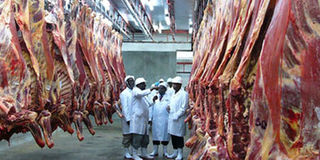Kenya loses billions in beef exports due to poor standards, reveal vets

Kenya Meat Commission plant in Athi River.
What you need to know:
- According to the International Organisation for Animal Health, the body that sets standards on which world trade regulations are based, a veterinary surgeon must certify animal products before they are allowed into the international market.
- Dr Kahariri said as a result, the safety of meat is highly compromised and thus can no longer access the international market.
Kenya loses about Sh3 billion annually in livestock exports for failing to meet the international animal health standards, the Kenya Veterinary Association has said.
The association’s vice-chairman ,Dr Samuel Kahariri, said the sector has declined sharply in Kenya and in the other member countries of the Intergovernmental Authority on Development (IGAD).
He said before the slump, Kenya was the only IGAD member that had secured quota-guaranteed access to the European market under the Beef/Veal Protocol of the Lome agreement between the EU and the African, Caribbean and Pacific group of states (ACP).
“Kenya has created a livestock department that is filled by professionals trained on crop and food sciences, leaving the main specialties like range management, animal health assistants, and veterinary doctors out,” he said.
Dr Kahariri said as a result, the safety of meat is highly compromised and thus can no longer access the international market.
DRUG RESIDUES
At the same time Dr Kahariri said lack of veterinary surgeons and paraprofessionals in arid and semi -arid lands (Asal) has led to increase in cases of human and animal diseases as well as drug residues in most animal products, hence their rejection in the international markets.
“Private practice is not viable in Asal areas and this has seen a steady increase in rabies, Rift Valley fever, brucellosis and anthrax in human beings,” he added.
Under-staffing has also contributed to declining livestock production. According to the 2009 census, there were approximately 100 million livestock in the country and only about 300 veterinary surgeons. The situation is worsened by the fact that about 100 of them are policy makers and only 500 veterinary are paraprofessionals.
“It is sad that the ratio of veterinarians to livestock stands at one veterinarian for 500,000 animals,” said Dr Kahariri.
He said most of the officers are over 50 years old and will retire from the public service in the next 10 years.
According to the International Organisation for Animal Health, the body that sets standards on which world trade regulations are based, a veterinary surgeon must certify animal products before they are allowed into the international market.
Dr Kahariri said due to lack of facilities such as computers, veterinary officers are unable to monitor animals.
“This surveillance system, which is a critical component in international trade, is very weak and therefore the animal products cannot access the market,” he said.
Other issues dragging down the sector include unmotivated work force due to poor salaries, infiltration of the sector by quacks, and poor regulation of veterinary drugs.
The vets now want the government to harmonise remuneration of veterinary doctors with that of medical doctors. They also want to be paid non-practising allowance and animal handling allowance.
Besides, the vets want the Sh5,000 risk allowance increased, saying they face many risks while on duty.
“Unlike medical doctors, our clients are hostile and could turn against us anytime we are treating them,” said Dr Kahariri.
The vets say for Kenya to reclaim its lost market, qualified officers should be hired. County governments, they say, should employ two veterinary surgeons and four veterinary paraprofessionals. They also want the government to set aside enough funds in the 2014/2015 budget to buy essential equipment and motor vehicles to enable them to carry out their duties effectively.





